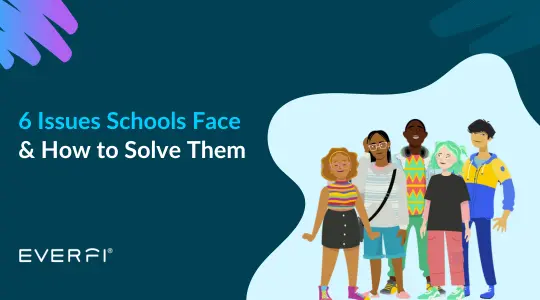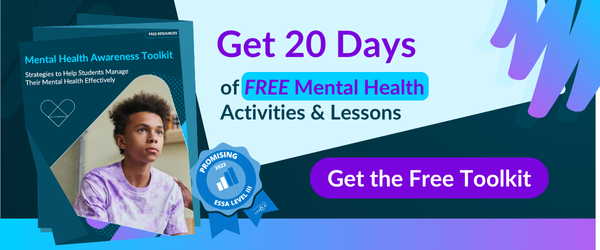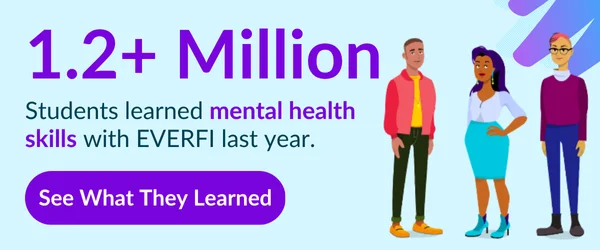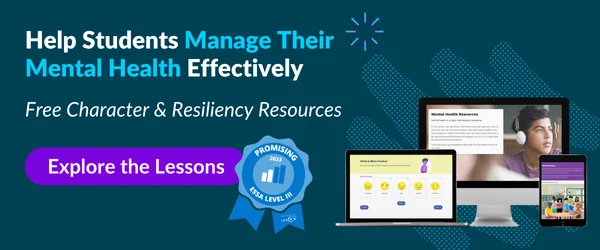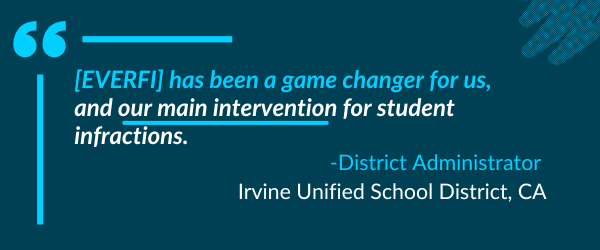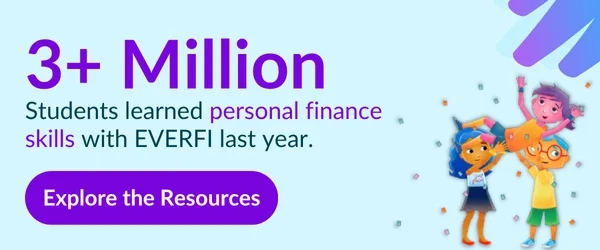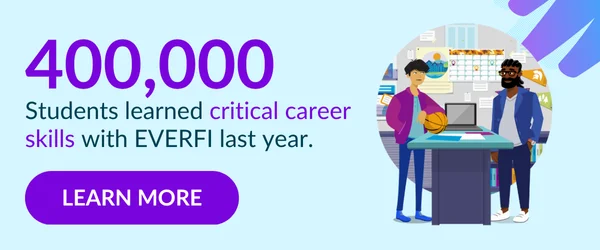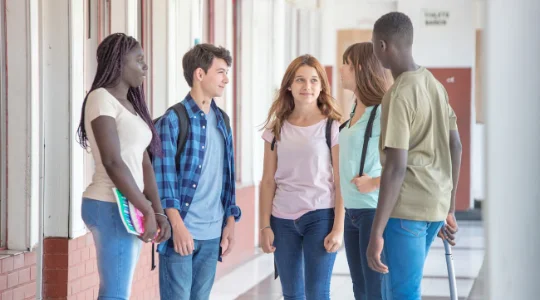In today’s ever-evolving educational landscape, schools are facing new challenges that require new solutions. Staying ahead of current issues in education is vital for creating effective, supportive learning environments that allow students and educators alike to thrive.
Here, we’ll explore a variety of the issues schools face today, including student mental health and well-being, digital and financial literacy for students, and other public education issues. We’ll also explore the actions administrators can take to support staff and students alike as well as the support that they can receive from Everfi at no cost.
Table of Contents
- Student Mental Health and Well-Being
- Teacher Burnout and Retention
- Bullying
- Digital Literacy and Online Safety
- Fostering a Welcoming Learning Environment
- Strengthening Financial Literacy
- What administrators can do
- How Everfi can help
Current Issues in Education
Staying on top of and addressing issues and concerns in education in today’s K-12 environment is key to supporting student well-being, teacher retention, and a positive school culture.
Student Mental Health and Well-Being: How Does School Affect Mental Health?
Thankfully, mental health is less stigmatized than in eras past, but many students still struggle to get the mental health support they need to feel their best.
According to a 2023 study from the Centers for Disease Control:
- 40% of high school students experienced persistent feelings of sadness or hopelessness.
- 20% of students seriously considered suicide.
- Female and LGBTQ+ students were more likely to experience mental health issues (including suicidal thoughts) than students in other groups.
- Nearly 32% of teens have an anxiety disorder.
Students struggling with their mental health may appear preoccupied, distant, or disengaged when, in reality, they’re simply trying to get through the day. Addressing student mental health needs can help them refocus in the classroom.
Challenges for Schools: Addressing mental health in schools can be difficult due to budgetary constraints. In schools that do offer counseling services to students, there is often a high student-to-counselor ratio that makes it difficult for students to get mental health support in schools.
While the American School Counselor Association recommends a ratio of 250 students per counselor, many schools don’t meet this recommendation. Academic pressure and focus can also present challenges in addressing mental health, as administrators often lack enough discretionary funding.
Solution: Integrating mental health solutions into the school curriculum is a smart, effective way to provide students with the tools they need to understand and improve their mental health. When mental health is part of a school’s curriculum, students who are struggling will understand that they’re not alone. They’ll also learn that mental health problems are common and that asking for help is a sign of strength.
Want to learn how other districts are building more self-aware and resilient students? Read the National Report on Mental Wellness Education.
Schools aren’t alone in their quest to improve student mental health.
Everfi provides all K-12 districts with free mental health lessons.
Aligned to CASEL and state standards, teachers love how the interactive lessons help teach topics like:
- Compassion
- Character
- Online safety
- Coping skills and more
Turnkey and bite-sized, Everfi’s resources are used in all grade levels with the most common placement:
- Classroom centers in elementary school
- Health and wellness classes
- Homeroom/advisory classes
When mental health is discussed openly in the classroom, students can feel more comfortable talking about their own struggles.
24% more students report being likely to talk to friends about mental health problems after completing Everfi’s free Understanding Mental Wellness resource.
Teacher Burnout and Retention
Between long hours, teacher-parent communication challenges, difficult student behaviors, large class sizes, ever-changing certification and licensing requirements, and heavy day-to-day workloads, teaching is tough. Many teachers struggle with burnout, no matter how dedicated they are to their school and their students.
When teachers are unhappy at work, it’s harder to keep excellent educators in the classroom. With 44% of K-12 teachers reporting feelings of burnout — and 30% of teachers were chronically absent, it’s vital that we work to solve this issue (or at least greatly reduce it).
Challenges for Schools: Low job satisfaction isn’t just a problem for teachers — it’s also a problem for students. When teachers are unhappy and overworked, the quality of their teaching and, therefore, the quality of their students’ learning can suffer.
Students benefit from teachers who feel fairly compensated, appreciated, and equipped with the tools necessary to do their jobs. Teachers who struggle with feelings of burnout are finding it harder to stay in the classroom. In fact, more than half of all teachers say they plan to leave the classroom sooner than they originally planned.
Solution: Thankfully, there are steps that school districts can take to address and prevent teacher burnout. Learning how to support teacher mental wellness can boost job satisfaction and teacher retention rates.
While the exact needs of districts differ, there are some general programs and promotions that districts can implement to support teacher well-being.
- Address workload issues
- Provide mental health and wellness resources
- Promote a healthy work-life balance
- Ensure competitive compensation and benefits
Bullying
In today’s digital world, the types of bullying students experience are often invisible, but it has by no means disappeared.
Cyberbullying — the practice of humiliating, harassing, or spreading rumors about others online or through text messages — has made it easier for bullies to act in secret.
In 2024, nearly 20% of students reported being victimized by in-person or online bullies. While the types of bullying have changed, the effects of bullying have not. Studies show that, over time, persistent bullying can lead to depression and anxiety, as well as feelings of isolation and despair.
Challenges for Schools: Since bullying often happens in secret, it can be hard for teachers and administrators to find effective solutions that support victims and create positive behavior changes in perpetrators. Some students feel uncomfortable reporting bullying for fear of retaliation or for fear of getting in trouble for their own participation in previous or current bullying.
Solution: Bullying is a complicated issue, and a whole-community approach is required to create a lasting school climate change. Teaching students how to handle bullying before it occurs (teaching empathy, conflict resolution, and safe reporting practices) can help squash conflicts that arise and create a positive school culture.
Looking for anti-bullying resources? Everfi’s free Honor Code resource provides students with real-life scenarios that enable students to:
- Identify bullying and its impact
- Treat themselves and others with respect
- Build emotional management techniques
- Stand up for themselves and others
25% more students report being at least somewhat confident that they can prevent bullying at their school after completing Everfi’s free Honor Code – Bullying Prevention resource
Digital Literacy and Online Safety
Technology is an integral part of modern life, and students need to become digitally literate to thrive academically, socially, and in their eventual chosen career paths. Providing students with the skills they need to navigate the digital world is essential for both school and life.
Challenges for Schools: Gaps in digital literacy can put students at an educational disadvantage and can pose a safety risk. Without the skills necessary to critically evaluate information, manage online interactions in socially acceptable and responsible ways, and protect their personal data, students are left vulnerable to the sometimes-nefarious digital world.
Solution: Digital citizenship skills are key to helping students protect their safety online and use the internet and other types of technology to their advantage in their academic careers.
By incorporating digital literacy into your life skills projects for high school students, you can give them the skills to identify fake news and fraud as well as keep a clean digital footprint.
Examples of digital literacy skills:
- Competency with basic software such as internet browsers and social media apps.
- Media literacy skills, including how to verify when someone is making false claims.
- Communication skills, including writing formal and informal emails.
- Using cloud-sharing technology to navigate the digital world.
- The ability to search for and apply for jobs.
Looking for great digital literacy and online safety resources? Everfi’s free Ignition lessons are one of its most popular resources year after year.
Thousands of schools use it each year at the start of each semester to refresh students on the skills necessary to be considerate and safe digital citizens.
“[Everfi] has been a game changer for us and our main intervention for student discipline infractions.” –District Administrator, Irvine Unified School District, CA
Fostering a Welcoming Learning Environment
Creating a welcoming learning environment goes beyond merely accepting differences. It involves celebrating the unique qualities of each student and fostering a culture of respect that embraces various backgrounds, perspectives, and circumstances.
Building respectful, inclusive learning environments requires intentional efforts that include careful modeling, open conversations, and the creation of a culture of respect.
Challenges for Schools: Implicit biases among students, educators, and administrators, along with systemic issues and varying socioeconomic levels, can make fostering a welcoming learning environment challenging. This doesn’t just affect students currently in classrooms; it can affect future generations as well. Taking steps to address both implicit and explicit biases can help to shape a better future for current students and those who will follow in their footsteps.
Solution: There’s not a single solution for creating welcoming learning environments. Creating a space in which all students feel valued and included can take time, and your approach may need to adjust as social issues, school climate, and different biases arise.
Chicago Public Schools works hard to foster inclusive and connected school cultures via restorative practices. Learn more about restorative practices and its impact on students by watching the on-demand learning with CPS and Everfi.
Financial Literacy for Students
Many students graduate from high school with little to no understanding of how to manage their finances, which sets them up for failure from the moment they receive their first credit card offer in the mail. Teaching students how to be financially literate citizens helps prepare them for success in their academic careers and beyond.
Challenges for Schools: Society recognizes that financial literacy is key for real-world success. That’s why over half of all states require personal finance instruction prior to graduation. While states are increasingly implementing this requirement, many districts struggle to find room in the budget to fulfill these often unfunded (yet important) mandates.
Solution: Everfi provides all K-12 schools turnkey access to its suite of financial literacy lessons making it easy for schools to offer age-appropriate lessons at no cost.
Last year, more than 2.6 million students in grades 4-12 used Everfi to develop their financial literacy skills. Some of the topics covered in our financial literacy courses include:
- Responsible decision making
- Goal setting
- Budgeting, saving, and investing
- Entrepreneurship
- Credit and debit
- Cryptocurrency
- Financing higher education
Click here to learn more about our financial literacy resources and help set your students up for success for years to come.
“Financial literacy is an important life skill that Everfi is providing our students free of cost. Every high school student in America needs to be exposed to this course. I am so glad my students have an opportunity to learn this valuable life skill through Everfi.” – High School Teacher, GA
What Administrators Can Do
As an administrator, you have a unique opportunity to support your teachers and your students by:
- Building partnerships. No one is a silo, and in a school, students, teachers, and administrators need to hear one another to succeed. Keeping open lines of communication can help you build the partnerships that you need to create a positive learning environment.
- Leveraging data and feedback. Numbers speak, and data-based decisions can lead your school toward growth. Use feedback and data from students and teachers to inform the next steps when it comes to choosing focus areas for your building and to develop effective teacher retention strategies.
- Creating a safe environment. Providing teachers and students with training that teaches them how to create a welcoming, safe environment for all can contribute to building a positive school culture.
- Integrating holistic resources. Integrating holistic resources educates your students to function as well-rounded global citizens.
- Empowering and supporting teachers. Your teachers need to know that you care and are there to support them and provide them with the industry-best professional development opportunities and resources to reduce their workload.
How Everfi Can Help
From bullying to student mental health to teacher burnout, it’s a difficult time to be a part of the leadership team of a K-12 school. As an administrator, you work hard to create a safe, supportive, encouraging environment for staff and students alike. Staying on top of the latest issues in public education can help you take proactive measures to create a healthy and productive environment in your building.
At Everfi, we’re here to help by providing your district with no-cost:
- Access to Everfi’s network of industry partners: Comprised of hundreds of national and local partners such The MassMutual Foundation and UBS, Everfi’s partner network provides teachers and students with opportunities to take part in digital and in-person learning events as well as college scholarship contests.
- 40+ Life Skills Resources: Aligned to your state’s standards, each of Everfi’s award-winning resources are turnkey providing teachers with immediate assessment scores, supplemental lessons, and 24/7 tech support.
- District-wide and individualized professional development: Tailored to meet your needs, Everfi provides districts and teachers with training and 24/7 support to supercharge your district’s unique priorities.
- Real-time data and feedback: Teachers can quickly assess student learning via Everfi’s easy-to-use platform then select the appropriate extension activity to reinforce learning. Administrators get regular Impact Reports showing school and student usage, learning gains, behavioral changes and more. Everfi then works with leaders to create a personalized support plan to help meet district goals.
Want to learn more about Everfi’s free resources and support? Schedule a 15-minute call with our District Support Team today!
“We have found that using Everfi programs in our district has given us the opportunity to provide education in many critical areas. These comprehensive, evidence-based programs have allowed us to empower our students with vital information that will last well beyond their school years.” – District Administrator, FL

Amanda Berkey is a Pennsylvania-based writer and reporter with an M.S.Ed. in School and Mental Health Counseling. With 17 years of experience in education, she has taken on diverse roles in teaching, coaching, and administration.
Free for All School Districts
Thanks to partners, we provide our digital platform, training, and support at no cost.
See why 3 out of 5 districts partner with Everfi.
